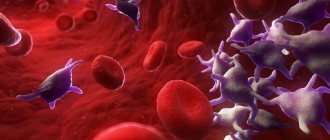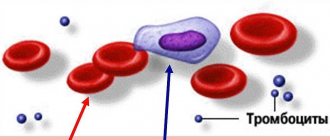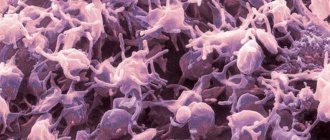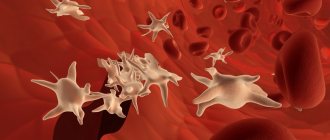Platelets are the smallest formed elements of blood that provide primary hemostasis of the body. They stop capillary bleeding and prevent vessel fragility. The norm for their content is 150‒400*10⁹/l; if the amount is less than the permissible value, they speak of thrombocytopenia.
This condition is fraught with internal bleeding, extensive hematomas, and stroke, and therefore requires control and correction. Thrombocytopenia can be caused by hereditary diseases, cancer pathologies, nutrient deficiencies, and damage to internal organs. To get rid of deviation, you need to find its causes and take action.
All about platelets
Small blood cells have an oval or round shape, a flat and smooth surface. Their diameter does not exceed 1–2 microns. They are produced by special cells of the red bone marrow - megakaryocytes.
The latter are large cells with long processes (up to 120 microns in length); they are completely filled with cytoplasm. Under the influence of the hormone thrombopoietin, the processes of megakaryocytes are fragmented and separated, so platelets appear that circulate in the peripheral blood. With a larger number of them, the production of thrombopoietin decreases. Thus, the body maintains a balance between the destruction of blood cells and their formation.
Platelets live for about a week (6–8 days). After this time, the structure of the cells changes, with the blood flow they enter the spleen, where they are captured by special tissues and utilized.
Role of cells
Blood clot-forming elements usually circulate in the body in an inactive state. The transition to the active form is provoked by any irritation (changes in biochemical conditions inside the body, pressure on tissues, cell damage, inflammatory processes). Under the influence of these factors, platelets change shape, and numerous processes appear on their surface. Such a cell resembles a shapeless star.
Transformed platelets carry out primary hemostasis. They cling with processes to the damaged area of the vessel (adhesion process), as well as to each other (aggregation). When collected in large quantities, they form a conglomerate or platelet plug. This is a kind of clot that closes the damage to the vessel and does not allow blood to flow out. The process takes 2–4 minutes. It has been proven that platelets secrete special biologically active substances - growth factors. They stimulate cell regeneration and growth, restoring tissue from the inside.
Blood levels
The number of platelets per unit volume of biomaterial is determined as part of a general blood test (read more about the platelet rate here). In the study protocol, the cells are designated PLT or Platelets. Physiological indicators depend on the person’s age.
Table - Platelet norms
| Population category | Reference value, *10⁹/l |
| Adults | 180‒320-400 |
| 10‒15 years | 150‒450 |
| 5‒10 | 180‒450 |
| 1‒5 | 150‒400 |
| 6‒12 months | 160‒390 |
| 1‒6 | 180‒400 |
| 10‒30 days | 150‒400 |
| Newborns | 99‒421 |
The level of platelets can change during the day, under the influence of external or internal factors. As a rule, fluctuations are short-term, do not go beyond the norm, and quickly correct themselves. The number of cells decreases in the blood of women during menstruation and when taking certain medications. The condition when the cell count falls below 150 is called thrombocytopenia; if it rises above 400, it is called thrombocytosis (see “Elevated platelets in the blood”).
How to determine deviation
You can determine that platelets are low using tests to evaluate:
- bleeding time;
- PLT level.
With a low platelet count, blood clotting worsens, which is why small wounds can cause extensive blood loss.
Diagnosis for low PLT includes:
- repeat blood test;
- testing for the presence of antibodies in blood plasma;
- Ultrasound of the liver and spleen;
- genetic tests.
Symptoms
In adults, low platelet levels are manifested by symptoms:
- frequent nosebleeds;
- bleeding gums;
- causeless appearance of bruises;
- hemorrhagic skin rashes in the form of nodules filled with blood;
- slow healing of small cuts;
- the appearance of blood in the urine.
Analysis and decoding
The normal PLT for adults of both sexes is considered to be 180-320*109/l. In women during menstruation, the norm is 75-220, and during pregnancy, normal PLT values are 100-310*109/l.
If platelets are below normal, a state of thrombocytopenia develops. A decrease in platelet count to 160 *109/l does not adversely affect health.
Thrombocytopenia is a blood condition in which PLT is below 160*109/l. Depending on the decrease, there are 3 degrees of thrombocytopenia:
- First degree or moderate (PLT within 50-160*109/l).
- Second degree or sharply reduced level (PLT value in the range of 20-50*109/l).
- Third degree or marked decrease (the number of PLT cells is less than 20*109/l).
If the first blood test shows a drop in platelets, the doctor will order a repeat test to confirm the permanent rather than temporary nature of the disorder.
At low values, increased bleeding is observed in the form of pinpoint hemorrhages from small vessels and capillaries. Bleeding develops when the levels drop to 50*109/l. A level of blood platelets reduced to 10*109/l causes a condition that can lead to death.
Important information: What do elevated monocytes in a child’s blood indicate (causes of monocytosis in children)
Why is platelet deficiency dangerous?
A lack of blood clot-forming elements poses a threat - the risk of bleeding increases. Internal hemorrhages can go unnoticed, lead to heavy blood loss and even anemia. Most often they are localized in the gastrointestinal tract, are diagnosed accidentally, periodically recur, and can intensify. Regular blood loss leads to posthemorrhagic anemia.
Adverse effects of thrombocytopenia include retinal and brain effusions. In the first case, the patient needs prompt medical care. Saturation of the retina with blood leads to the development of blindness. The first symptom is blurred vision, a feeling of a spot on the eye. In the future, these manifestations only increase.
Hemorrhage in the brain leads to the death of its cells, which is fraught with serious disruptions in the functioning of the entire body and tissue swelling. A quarter of such cases end in the death of the patient.
Causes and types of thrombocytopenia
A deficiency of the smallest blood cells always means an increased risk of bleeding for the patient. The condition indicates an imbalance in the formation and destruction of cells. There are congenital conditions accompanied by insufficient platelet synthesis. If they are produced in small quantities, they speak of true thrombocytopenia. When the deficiency is temporary, caused by disturbances in the functioning of internal organs, the condition is called secondary. If the deficiency is temporary and can resolve itself (for example, heparin-induced thrombocytopenia, or caused by a lack of vitamins in the body), it is called transient. Based on the level of cells in the blood, the degrees of their deficiency are distinguished:
- light;
- average;
- heavy.
Depending on the pathogenesis, there are several types of thrombocytopenia.
Hereditary
These include thrombocytopenia caused by gene mutations and disorders of their structure. These are rare diseases and syndromes acquired from close relatives:
- Mey-Hegglin is a hereditary pathology in which the process of platelet separation is disrupted (they are formed in smaller numbers, but are larger in size), and in parallel the production of leukocytes is disrupted;
- Wiskott-Aldrich is a hereditary disease of boys, which produces platelets that are too small, which are soon destroyed in the spleen, and is combined with disturbances in the functioning of the immune system;
- Bernard-Soulier - pathology develops only in that case. if both parents are carriers of the defective gene, it produces huge, functionally incompetent platelets;
- TAR - congenital thrombocytopenia is caused by impaired development of megakaryocytes under the influence of a mutated gene, combined with the absence of radial bones.
Amegakaryocyte thrombocytopenia is also isolated. This condition is accompanied by a genetically determined lack of sensitivity of bone marrow cells to thrombopoietin. They do not respond to the hormone and therefore do not produce blood platelets.
Thrombocytopenia destruction
This is the name for conditions in which blood cells are broken down or utilized faster than they are released from the bone marrow. Thrombus-forming elements can be damaged in the spleen, and in much smaller quantities in the liver and lymph nodes. Injuries also lead to active destruction, then the formed elements are damaged directly in the vascular bed. A sharp decrease in platelet levels is observed with:
- thrombocytopenic purpura (autoimmune thrombocytopenia) - the causes of the disease are unknown, during it antibodies are produced to blood cells, due to which formed elements are intensively captured and destroyed in the spleen, liver, lymph nodes, the compensatory capabilities of the bone marrow are gradually depleted;
- Evans-Fisher syndrome - specific antigens appear on platelets and red blood cells, by which the recycling organs recognize them as foreign and destroy them; the causes of the syndrome have not been fully elucidated;
- thrombocytopenia of newborns - the condition begins to develop at the 20th week of pregnancy, if the mother’s immune system “wary” perceives the child’s genetic material, the cells destroy immunoglobulins that enter the fetus’s body through the blood-brain barrier.
Destructive thrombocytopenias include those deficiencies of blood platelets that have developed due to the use of medications. Medicinal substances are able to come into contact with blood cell antigens, they form complexes that the immune system perceives as foreign material and produces antibodies. As a result, platelets labeled with the complexes live for several hours and are quickly destroyed in the spleen. After stopping the medications, the balance of the corpuscles should be restored. Drugs that lower platelet levels in the blood include:
- antiarrhythmic (Quinidine);
- antihistamines (ranitidine, cimetidine);
- anticoagulants (Heparin);
- antibiotics (Rifampicin, Cephalexin, Gentamicin);
- antidepressants.
Antibodies can form against blood cells that have come into contact with viral particles. Thrombocytopenia destruction can be provoked by rubella, chickenpox, influenza, measles.
Productive thrombocytopenia
This is the name for conditions in which the deficiency of corpuscles is caused by their reduced production in the red bone marrow. Disturbances can be caused by pathologies of the hematopoietic system, a lack of regulators of body synthesis, and abnormalities in the structure of producing cells.
Table - Causes of productive thrombocytopenia
| State | The essence |
| Alcoholism | Ethanol has toxic properties and inhibits the functioning of most organs and systems, including hematopoietic ones. Thrombocytopenia develops against the background of prolonged and active consumption of alcohol, in “binge drinkers” |
| Irradiation | Ionizing radiation can be the result of medical treatment or living in unfavorable conditions, it causes cell mutations or directly inhibits the formation of blood cells |
| Medicines | Some drugs reduce the activity of hematopoietic function. These include diuretics, antipsychotics, anticonvulsants, antithyroid drugs, NSAIDs and cytostatics. The latter inhibit platelet formation by inhibiting cell division throughout the body |
| Hypersensitivity | Increased sensitivity to pharmacologically active substances is not included in the list of side effects, but is an individual reaction of the body to certain compounds. It can manifest as inhibition of hematopoiesis and platelet formation |
| Metastases | At the terminal stages of a tumor disease, metastases almost always appear - the tumor grows into healthy tissues and provokes their replacement with atypical ones. Often metastases form in the bone marrow, which is accompanied by a comprehensive inhibition of hematopoietic function |
| Myelofibrosis | Fibrous degeneration of bone marrow stem cells occurs, which gradually displace functional cells |
| Leukemia | Malignant damage to the hematopoietic system is accompanied by degeneration and activation of the division of atypical stem cells, with the gradual displacement of healthy bone marrow tissue. Manifested by a decrease in the level of all blood cells |
| Megaloblastic anemia | It develops against a background of folic acid and cyanocobalamin deficiency and is accompanied by impaired cell division due to the inability to recreate DNA. Primarily affects those systems whose stability depends on the activity of cell division (mucous membranes, blood composition) |
| Myelodysplastic syndrome | Blood cells are produced, but do not fully mature, therefore they cannot perform functions and quickly undergo apoptosis (destruction). The condition is accompanied by thrombocyto-, leuko- and erythropenia |
| Aplastic anemia | This is the inhibition of all hematopoietic functions of the red bone marrow, accompanied by a deficiency of all types of blood cells. The causes of development may be chemotherapy, radiation exposure, poisoning, HIV |
Thrombocytopenia consumption
Such a deficiency of blood elements is observed when the compensatory capacity of the bone marrow is depleted against the background of active consumption of platelets over a long period. Before the level of cells in the blood decreases, there is a significant increase in them. Similar conditions are observed against the background:
- Thrombocytopenic thrombotic purpura. Cells on the inner surface of blood vessels produce a special substance - prostacyclin. It regulates platelet activity and prevents their adhesion and aggregation (sticking together). The lack of this factor provokes the formation of microthrombi, vascular damage, and hemolytic processes (with the destruction of red blood cells directly in the bloodstream).
- Hemolytic-uremic syndrome. When it occurs, toxins appear in the blood (infectious or due to taking medications), which damage the vascular walls. A large number of platelets are activated to correct these defects. As a result, blood clots form and microcirculation is disrupted. The syndrome is more often observed in children against the background of intestinal infections.
- DIC syndrome (intravascular coagulation). It develops with massive damage to tissues or internal organs (burns, transfusion of incompatible blood, necrosis, tumors, chemotherapy), shock conditions, and serious infectious lesions of the body. The release of mediators causes platelets to coagulate, forming a large number of blood clots and causing serious circulatory problems. Subsequently, the supply of cells is depleted, and against the background of activation of the anticoagulant system, multiple and massive bleeding develops, which can lead to the death of the patient.
Platelet redistribution
The spleen acts not only as a recycling organ, but also as a depositing organ for blood cells. As a rule, it stores a third of all platelets in the body. If it increases in size, almost all thrombotic bodies (up to 90%) can be retained in the tissues. Because they cannot be destroyed, the bone marrow does not activate megakaryocytes to compensate for the deficiency. As a result, the level of corpuscles in the total blood volume drops sharply. Changes in the size and function of the spleen occur when:
- autopathologies (systemic lupus, rheumatic diseases - rheumatoid arthritis, rheumatism of the joints);
- oncological diseases (leukemia, lymphoma);
- liver cirrhosis;
- alcoholism;
- infectious diseases.
Redistribution of platelets can also be caused by the growth of hemangioma, a benign tumor consisting of vascular epithelium. In its tissues, bodies can also accumulate and then be destroyed. After the tumor is eliminated, the situation returns to normal.
Thrombocytopenia dilution
It is observed in hospital patients who, due to their serious condition, are given a large number of blood substitutes (for bleeding, severe infections). Even activation of the depot and proper operation of compensatory mechanisms cannot correct the situation and optimize the state of the coagulation system. For platelet production to recover, it will take time and comprehensive treatment aimed at restoring all internal organs.
Useful information: Bilirubin in urine is increased: more than 3 reasons, what does this mean, normal, treatment in adults and children. What diseases can it talk about?
In children
Newborns and children up to six months are characterized by wider limits of platelet norms than adults. This is due to the development of the work of all internal organs. All of the above diseases can provoke a lack of corpuscles in a child.
Doctors note that the condition is common among premature babies, as well as those infants who had to undergo intensive care shortly after birth. If thrombocytopenia is not associated with pathologies of the blood, bone marrow and hereditary gene mutations, it goes away within a few months. In order to detect dangerous diseases in time, the blood picture must be regularly monitored.
In pregnant women
A decrease in platelet levels in an expectant mother is considered a natural process (up to 140*10⁹ units/l). This is the result of a restructuring of the body under the influence of hormones, increased load on internal organs, increased blood volume, and increased consumption of vitamins and minerals. If a woman does not have immune disorders, allergies, signs of intoxication or warning symptoms, no specific treatment is required. The doctor recommends that mom eat right, get plenty of rest, and avoid taking medications. After childbirth, the condition returns to normal.
In case of a sharp and significant decrease in platelet levels, inpatient monitoring is required. This may be a sign of serious illness, intrauterine fetal death. To accurately determine the cause, a comprehensive examination is carried out. If the level of cells drops to critical, the woman is treated in a hospital until the blood picture is completely normalized.
Interestingly, thrombocytopenia below 140*10⁹ units/l can only occur during pregnancy and disappear after childbirth. This is due to the peculiarities of the immune system during pregnancy.
Identification of idiopathic thrombocytopenia in a woman or a decrease in blood platelets of an autoimmune nature is an indication for delivery by cesarean section. Natural childbirth in this case sharply increases the risk of intracranial hemorrhages in the fetus of varying severity. To prevent this and preserve the child’s health, the operation is performed even if the obstetric situation is otherwise favorable.
The risk of intracerebral hemorrhage in the fetus is due to the fact that often a decrease in platelet levels in the mother is accompanied by a similar change in the level of platelets in the child. And this is a risk factor for bleeding. It is impossible to determine platelet values in utero in a child without umbilical cord puncture, and this procedure in itself is dangerous and is performed only in a few maternity hospitals.
Causes of Low Blood Platelet Levels
Finding out why platelets are falling, low platelets in the test results, this condition may indicate the following:
- Formation of platelets in small quantities, insufficient for the body,
- Their loss during chronic bleeding,
- Accumulation of platelets in the spleen,
There are also a number of diseases and factors that influence the reduction of blood clotting:
- Alcohol addiction,
- Colds,
- Mononucleosis,
- Hepatitis of various types,
- HIV and AIDS,
- Destruction of liver cells (cirrhosis),
- Using medications and herbs to thin the blood,
- Excessive consumption of liquefying foods
- When carrying a fetus,
- Sepsis,
- Leukemia,
- Tumors and metastases in the bone marrow,
- Herpetic infection,
- and others.
How does thrombocytopenia manifest?
The condition rarely manifests itself with clinical symptoms. Vivid signs appear only with a critical decrease in platelet counts. At the same time, the general well-being of the patient does not change. Often the symptoms of thrombocytopenia are combined with manifestations of the underlying disease (drowsiness, apathy, changes in body temperature, pain, rashes, symptoms of infection). The main way to diagnose the condition is a general blood test.
Since platelets control the blood clotting process, a sign of their deficiency is bleeding of varying intensity and location. The mucous membranes are the first to suffer, since they are actively supplied with blood and contain many small vessels passing close to the surface. Possible signs:
- bleeding gums - a person notices copious bleeding while brushing teeth, blood continues to flow from the vast surface of the gums for a long time after mechanical impact;
- prolonged bleeding after tooth extraction - normally it stops after 5-20 minutes, if there are problems, the time increases to an hour or more;
- nosebleeds - occur after sneezing, blowing your nose, clearing your sinuses, and are accompanied by heavy blood loss over a long period;
- purpura is the name given to the appearance of red dots (petechiae), spots (ecchymosis), hematomas on the body and mucous membranes; they are formed when small vessels are damaged, against the background of friction, pressure, minor impacts and even stroking.
In adults, poor blood clotting may manifest as signs of gastrointestinal bleeding. With prolonged losses, the color of the stool changes (it becomes black, tarry), and with intense bleeding, vomiting with blood appears. Possible effusions into the mucous membranes of the urinary tract, which is manifested by the release of blood in the urine.
In women, a sign of thrombocytopenia is heavy and prolonged periods. Normally, menstruation lasts 3–5 days and is accompanied by a loss of up to 180 ml of blood. A violation should be suspected if a lot of blood is lost through the discharge or if intense bleeding continues for more than 5 days.
An adult's blood has low platelets, what does this mean?
In this case, the value of the indicator should be less than 150 * 109 cells per liter.
Important: a decrease in platelets in the blood of pregnant women to 100 - 150*109/l is normal.
The state of low platelets in the blood can be an independent pathology or accompany hematological pathologies. Low blood platelets are often observed in autoimmune diseases - thrombocytopenic purpura and primary immune thrombocytopenia.
Low blood platelets in adults can occur with:
- congenital thrombocytopenic conditions;
- aplastic anemia;
- enlarged spleen;
- infectious pathologies;
- drug thrombocytopenia;
- autoimmune hemolytic anemia, etc.
Thrombocytopenic purpura
The disease accompanies conditions when the patient experiences a decrease in platelets and increased bleeding. Against the background of immune disorders, the production of protective protein antibodies against healthy cells of the body, in particular platelets, is activated. As a result, their increased destruction is observed.
The disease manifests itself in the form of spontaneous hemorrhages or increased bleeding due to minor mechanical injuries. The extent of hemorrhages varies from pinpoint to extensive. The resulting bruises are painless upon palpation and do not rise above the surface of the skin. The patient also experiences frequent bleeding from the nose, gums, hemorrhoidal veins, uterine bleeding in women, etc.
Spontaneous gastrointestinal bleeding is possible.
Important: with thrombocytopenic purpura, the size of the spleen does not change. This makes it possible to differentiate the pathology from others with a similar clinical picture.
There are 5 forms of pathology:
- true, the etiology of which remains unknown;
- isoimmune - manifests itself when the wrong type of donor blood is transfused;
- neonatal – typical for newborn babies. The mechanism is the penetration of maternal antibodies through the placenta;
- autoimmune – consists of a combined manifestation of purpura with systemic lupus erythematosus or hemolytic anemia;
- symptomatic, which occurs in diseases not related to the immune system. For example, leukemia, infectious infection and radiation damage to the body.
The most dangerous complications are cerebral hemorrhages and extensive bleeding.
Idiopathic thrombocytopenic purpura
The disease manifests itself in the form of wave-like symptoms. The clinical picture is characterized by a lack of platelets, which acquire enormous sizes. At the same time, the level of megakaryocytes (platelet precursors) remains normal or increases slightly. In 50% of patients, the presence of protein antibodies to platelets is recorded in a blood test.
The prevalence of the pathology varies from 1 to 15 cases per 100 thousand people. Among them, women aged 20 to 40 predominate. A hereditary predisposition to transmission of the disease has not been established.
The mechanism for the development of pathology is the production of antibodies against one’s own healthy cells and tissues. However, the fact that antibodies are not detected in all patients leaves the question of the final pathogenesis open. It has been noted that in children the cause of the manifestation of idiopathic thrombocytopenic purpura is infection with a viral respiratory infection.
Treatment methods are selected individually by the attending physician. In critical situations, the patient is given intravenous administration of platelet-rich plasma.
How to find the causes of thrombocytopenia
Abnormalities found during a general blood test in the absence of complaints and specific symptoms are a reason to consult a hematologist. This specialist understands all pathologies associated with hematopoiesis and disorders of blood homeostasis. It is important to evaluate all analysis information as a whole. Changes in the number of other cells, along with platelets, can be a diagnostic sign of the disease. In addition to OAC, the following are used to determine the causes of thrombocytopenia:
- general urine analysis;
- biochemistry and blood microscopy;
- Duke test (blood clotting time);
- coagulogram;
- red bone marrow puncture;
- genetic tests;
- test for antibodies to platelets.
If pathologies of internal organs are suspected, imaging diagnostic methods (ultrasound, CT, MRI) are prescribed. With their help, it is possible to detect spleno- and hepatomegaly, tumor structures, and cirrhosis. Only after differentiation, assessment of the severity and causes of thrombocytopenia, the doctor can prescribe treatment.
Clinical guidelines for the treatment of thrombocytopenia
Patient management tactics and treatment methods completely depend on the severity of his condition. It is determined by the level of clot-forming cells in the blood.
Table - Degrees of thrombocytopenia
| Severity of the condition | Possible symptoms | What to do |
| Light (50‒150*10⁹/l) | There are no or complaints of nosebleeds, hematomas on the body that do not correspond to the area of injury | Complete examination as planned, on an outpatient basis |
| Average (20‒50*10⁹/l) | Bleeding of mucous membranes, signs of hemorrhagic syndrome | Full examination, treatment at home, limitation of physical activity |
| Heavy (up to 20*10⁹/l) | Heavy bleeding, extensive hemorrhages in the skin and mucous membranes, other disorders | Examination, observation and treatment in hospital |
If the patient has hemorrhages in the head and face, hospitalization is required. These symptoms indicate a high risk of stroke. If abnormalities in tests (even minor ones) are found in a child, teenager, pregnant woman, or elderly person, you should definitely visit a doctor. For the listed categories of the population, there is a high risk of pathologies of the hematopoietic organs.
Drug therapy
The purpose of prescribing medications is to correct the symptoms of hemorrhagic syndrome and treat the disease that caused thrombocytopenia. They are selected only after a comprehensive examination. You cannot take any medications on your own; if taken incorrectly, they can aggravate the situation. Most often, drug therapy is prescribed for autoimmune thrombocytopenia. It uses the following drugs:
- Prednisolone. Prevents the production of antibodies and their fusion with platelets, regulates the strength of vascular walls. Treatment lasts a month, the initial dose is 40–60 mg in 2–3 doses. The drug is discontinued gradually.
- Vincristine. Antitumor agent, regulates the production of antibodies. It is used once a week (intravenously) at a dose of 0.2 mg per 1 kg of patient body weight.
- Dexamethasone. Used for chronic forms of autoimmune thrombocytopenia. A daily dose of 40 mg is administered for 4 days, which allows achieving remission in half of the patients.
- Depo-Provera. Prescribed to women with heavy bleeding, to prevent significant blood loss. Eliminates menstruation for 3 months by suppressing the production of luteinizing hormone. A long-acting agent, administered once every 3 months.
- Cyanocobalamin. Prescribed for various anemias at a dose of 300 mcg daily for 1–2 months.
- Etamzilat. Take 500 mg three times a day to prevent and eliminate hemorrhage and normalize blood microcirculation.
- Revolade. A synthetic agent used to replace thrombopoietin. stimulates the maturation of megakaryocytes and the separation of functional platelets. Used in tablets, 50–75 mg once a day.
- Immunoglobulin. Administered intravenously for idiopathic or viral thrombocytopenia, to prevent the production of antibodies to blood cells.
If the level of platelets is critically low, a transfusion of a blood component, platelet concentrate, is performed. The drug is also administered before planned operations in people with thrombocytopenia.
Dietary recommendations
There is no specially designed diet to increase platelet levels in the blood. Doctors recommend focusing on a balanced and healthy diet with the correct ratio of dietary fat. Of particular benefit will be foods rich in unsaturated fatty acids:
- fish;
- eggs;
- vegetable oils;
- nuts;
- flaxseed, pumpkin seed.
The diet should contain sufficient sources of easily digestible protein (cottage cheese, dairy products, chicken, turkey), as well as fresh vegetables and fruits (to enrich the menu with vitamins). To avoid injury to the mucous membranes, it is recommended to eat food after mechanical processing (in the form of puree, soufflé, minced meat), as well as at a neutral temperature.
There is no list of foods that lower platelet levels in the blood. However, there are definitely known dishes that negatively affect the entire body and health in general (smoked meats, animal fats, sweets, processed foods, alcohol, strong coffee, soda).
What to do
If signs of a decrease in PLT cells appear, you need to take a general blood test and visit a therapist. If necessary, he will prescribe additional tests and refer you to a hematologist.
Important information: How are leukocytes designated in a general blood test in Latin letters (table)
A decrease in platelets occurs in every person throughout life. A slightly reduced platelet level may indicate a previous infection, minor blood loss, or a lack of vitamin B12.
If the indicators are slightly underestimated, platelets in the blood can be increased with the help of a balanced diet and a proper daily routine.
Nutrition
A decrease in PLT can be caused by a lack of essential vitamins for hematopoiesis in the diet. Proper nutrition stimulates the production of blood platelets. If there is a lack of platelets, it is useful to enter into the menu:
- vegetables (leafy greens, legumes, beets);
- fruits (citrus fruits, apples);
- nuts;
- lean boiled fish;
- lean beef, rabbit meat;
- beef liver;
- egg;
- cereals (buckwheat);
- rosehip decoction;
- dairy products (cheese).
The diet should contain foods rich in retinol, folic acid, and ascorbic acid. Orange-colored vegetables (carrots, pumpkin) contain a lot of retinol. An increased amount of ascorbic acid in currants, lemons, and bell peppers.
Folic acid is found in all green vegetables and leafy greens, but is easily destroyed by cooking. To provide the body with the necessary amount of folic acid, it is necessary to include salads with fresh herbs in the menu.
Platelets decrease if there is not enough vitamin B12 in the diet. There is a lot of it in liver, seafood, cottage cheese, and whole milk.
If you have low platelets, you should exclude foods that have a suppressive effect on the immune system from your diet. These include alcohol and drugs.
By suppressing the immune system, they inhibit hematopoiesis in the bone marrow, which increases the degree of thrombocytopenia.
Healthy lifestyle
When platelets are low, physical activity must be reduced by eliminating heavy training and excessive physical activity at work. The daily routine is designed in such a way that a person can work no more than 8 hours and sleep no less than 9 hours.
To normalize blood tests, it is necessary to completely abandon bad habits.
Medicines to strengthen the immune system
If the level of platelets in the blood is low, medications are prescribed to restore the hematopoietic function of the bone marrow. To increase platelet counts the following is prescribed:
- aminocaproic acid;
- Etamsylate;
- Vikasol;
- immunoglobulins.
Thrombocytopenia caused by an autoimmune disease is treated with hormonal drugs Methylprednisolone, Dexamethasone. Enhanced platelet production is achieved by prescribing thrombopoietin, biostimulants, vitamin B12 and folic acid.
The duration of drug treatment is up to 6 months or more. In case of autoimmune diseases, liver damage, oncology, treatment has to be prolonged, and sometimes you have to take medicine to raise platelets for the rest of your life.
When platelets in the blood are sharply reduced, a platelet transfusion procedure is prescribed. If the disease is severe, it may be necessary to remove the spleen (splenectomy surgery).
If there is a sharp drop in platelets and there is an increased risk to life, the patient is prescribed a bone marrow transplant. The most common indication for transplantation is blood cancer, when the number of blood platelets in the blood is sharply reduced.
Important information: What does it mean to have low lymphocytes in the blood of an adult (reasons for the decrease)
Folk recipes
A number of medicinal plants used in folk medicine help reduce bleeding. Plants that reduce bleeding include:
- chokeberry;
- rose hip;
- beet;
- verbena;
- strawberries;
- nettle;
- yarrow.
You can use folk remedies only on the recommendation of your doctor.
If there are few platelets in the blood, you need to:
- Drink 100 ml of nettle infusion 2 times a day before meals. To prepare the infusion, pour 20 g of nettle into a glass of boiling water and leave in a water bath for 15 minutes.
- Make beetroot juice with the addition of honey and take 1 tbsp. before meals for a month.
- Drink nettle juice with milk for 2 weeks. To prepare, squeeze 50 ml of juice from nettle stems and add 50 ml of milk. Drink before meals.
- Eat lemon, grated with peel, with honey (a glass). To enhance the effect of the folk remedy, add a quarter tsp. sesame oil.
- Eat 50 chokeberry berries every day for 3 weeks.
FAQ
Question: Is it possible to have surgery for thrombocytopenia?
Answer: Surgery usually lowers platelet levels. Since there is a risk of significant blood loss, deviations in the general analysis are considered a contraindication. However, doctors make the final decision on an individual basis, focusing on the degree of corpuscle deficiency, the reasons for their deficiency and the urgency of the operation. If there is a danger to the patient’s life, the intervention will be carried out after special preparation of the patient (platelet mass is infused). Doctors will closely monitor his condition after surgery.
Question: Is it possible to get pregnant with thrombocytopenia? Can blood abnormalities affect conception?
Answer: It is advisable to check your blood picture and undergo a comprehensive examination 3 months before the planned conception. If deviations are detected, in-depth diagnostics are carried out to identify the causes of the violations. Only after they are eliminated can you become pregnant. Thrombocytopenia cannot significantly affect conception, but provoking pathologies can do so. It is better to deal with them in advance to eliminate the possibility of transmitting hereditary diseases to the child. Blood counts should be monitored throughout gestation, as low platelet levels may be a precursor to bleeding or preterm labor.
Question: Can large hematomas appear from massage? Should they be considered a sign of platelet deficiency?
Answer: The possibility of bruising completely depends on the sensitivity of the body and the massage technique. If a massage therapist uses excessive force during manipulations or uses auxiliary devices, damage to blood vessels with hemorrhages in the skin is possible, even in people with an ideal blood picture. However, if the hematomas are multiple, extensive and appear with minor exposure, it makes sense to get tested. If thrombocytopenia is suspected, massage should not be performed.
Question: Can vaccinations provoke the condition, which ones exactly?
Answer: After administration of the vaccine, transient thrombocytopenia is possible. This phenomenon will go away on its own without specific treatment. According to the instructions for vaccines, the possibility of reducing platelet levels exists only after vaccination against measles, rubella and mumps (combined drug).
Question: How to quickly lower platelet levels?
Answer: To reduce the number of corpuscles, you need to understand the reasons for their increase. If the condition is temporary and not associated with serious diseases, you can undergo a short course of treatment with acetylsalicylic acid. Doctors recommend consuming large amounts of vegetables, fruits, berries, fish oil, and also red wine in small quantities.
Features of the treatment of thrombocytopenia in children
In children, the disease most often develops as a result of Rh conflict with the mother's blood. Therefore, in the first month of life, donor milk or formula is used to feed the baby. Next, breastfeeding is gradually introduced with constant monitoring of platelet levels. Infants take medications on an inpatient basis.
Thrombocytopenia is characterized by a low level of platelets in the blood.
The following drugs are used for treatment:
- Prednisolone (dosage and course are calculated based on body weight and severity of the pathology);
- droppers or injections with immunoglobulin;
- donor blood transfusions;
- To strengthen blood vessels, a course of ascorutin or separate intake of vitamin P and C is prescribed.
To treat acquired thrombocytopenia as a result of the disease, drug therapy described above is prescribed, taking into account the age and cause of the decrease in platelets.
conclusions
Platelets are the smallest formed elements of blood. They are not considered full-fledged cells. The corpuscles are necessary to regulate vascular tone and stop minor bleeding. They are constantly produced and die in the body. The norms for their content in the blood are quite wide, but the number of destroyed and formed platelets should be approximately equal and stable. Deviations in indicators may indicate independent blood pathology or diseases of internal organs. The lack of corpuscles is designated by the laboratory term thrombocytopenia.
In addition to a decrease in platelet levels, it is possible that the level may exceed the norm. The condition is called thrombocytosis. An increase in the number of blood platelets sharply increases the likelihood of blood clots, and, consequently, strokes and heart attacks. Knowing the symptoms and causes of the pathological condition, as well as methods for correcting platelet levels, you can avoid such complications - read more about this here.
Severity of thrombocytopenia
Low platelets in the blood, the causes of which largely depend on hereditary predisposition, are divided into several types according to their course and severity.
Degrees:
- Easy . There are no symptoms. At the same time, platelet level indicators are at the upper limit. Does not require treatment or use of medications. Systematic observation by a doctor is necessary.
- Average . The patient suffers from frequent hemorrhages under the skin and nosebleeds. Treatment is required if bleeding occurs in internal organs.
- Heavy . Hemorrhaging processes affect all internal organs. Mandatory therapy and medical examination are required.
For any degree, constant monitoring by a hematologist and systematic preventive examinations are required.











